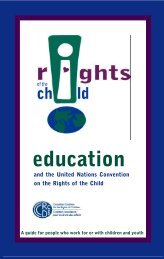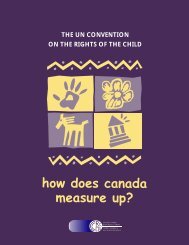CCRC report on rights of children in Canada - Canadian Coalition ...
CCRC report on rights of children in Canada - Canadian Coalition ...
CCRC report on rights of children in Canada - Canadian Coalition ...
You also want an ePaper? Increase the reach of your titles
YUMPU automatically turns print PDFs into web optimized ePapers that Google loves.
“Clubs and teams provide lots <strong>of</strong> opportunity. There are lots <strong>of</strong> clubs <strong>in</strong> high schools, not primary schools.<br />
Primary schools are cutt<strong>in</strong>g recesses. There is a need to organize clubs <strong>in</strong> younger grades and more<br />
th<strong>in</strong>gs to do are needed <strong>in</strong> primary school. For <strong>in</strong>stance, at some schools, <strong>children</strong> are not allowed to<br />
play <strong>on</strong> the play structures <strong>in</strong> the w<strong>in</strong>ter because they are deemed unsafe.”<br />
<str<strong>on</strong>g>CCRC</str<strong>on</strong>g> Youth C<strong>on</strong>sultati<strong>on</strong>, October 2, 2011<br />
f CHILDREN’S RIGHT TO PLAY<br />
Introducti<strong>on</strong><br />
Article 31, comm<strong>on</strong>ly known as the right to play article, is not menti<strong>on</strong>ed <strong>in</strong> the <strong>of</strong>ficial <str<strong>on</strong>g>report</str<strong>on</strong>g>s by the<br />
federal/prov<strong>in</strong>cial/territorial governments. It is not well known or widely used <strong>in</strong> <strong>Canada</strong>.<br />
Young people recommend these acti<strong>on</strong>s:<br />
• Government can help<br />
• Teachers should respect time for play — not<br />
too many hours<br />
• More pamphlets, more ads to parents to get<br />
knowledge, more opti<strong>on</strong>s so that kids can play<br />
what they like<br />
<str<strong>on</strong>g>CCRC</str<strong>on</strong>g> Youth C<strong>on</strong>sultati<strong>on</strong>, October 2, 2011<br />
Recommendati<strong>on</strong>s<br />
ACTION<br />
Learn about the right to play <strong>in</strong> article 31 and c<strong>on</strong>sider its<br />
implicati<strong>on</strong>s for households, communities, and all levels<br />
<strong>of</strong> public policy.<br />
In recent years, <strong>children</strong>’s physical activity has<br />
been <strong>on</strong> the nati<strong>on</strong>al public agenda <strong>in</strong> relati<strong>on</strong><br />
to c<strong>on</strong>cerns about obesity, not as a focus <strong>on</strong><br />
<strong>children</strong>’s development or <strong>rights</strong>. C<strong>on</strong>trary to<br />
the comm<strong>on</strong> percepti<strong>on</strong> that play is an opti<strong>on</strong>al<br />
activity for <strong>children</strong>, article 31 c<strong>on</strong>siders it an<br />
essential element for healthy child development,<br />
with far-reach<strong>in</strong>g implicati<strong>on</strong>s for society.<br />
Many factors h<strong>in</strong>der unstructured play. These <strong>in</strong>clude less free time, safety c<strong>on</strong>cerns, preference<br />
for structured programs, reduced natural spaces for play, more passive time <strong>in</strong> fr<strong>on</strong>t <strong>of</strong> screens, and<br />
pr<strong>of</strong>essi<strong>on</strong>als who do not understand its vital role <strong>in</strong> child development.<br />
Nati<strong>on</strong>al sport policy focuses primarily <strong>on</strong> the development <strong>of</strong> expert athletes, with less attenti<strong>on</strong> to<br />
<strong>children</strong>’s play. Recreati<strong>on</strong> policies at the prov<strong>in</strong>cial/territorial and municipal levels have a somewhat<br />
greater focus <strong>on</strong> <strong>children</strong>, but few explicitly recognize <strong>children</strong>’s right to play.<br />
C<strong>on</strong>cerns about safety <strong>of</strong>ten lead to reduced space for <strong>children</strong> to engage <strong>in</strong> unstructured play<br />
and explore the natural world. While progress has been made <strong>in</strong> preventi<strong>on</strong> <strong>of</strong> abuse <strong>in</strong> sport<br />
programm<strong>in</strong>g, 58 a comprehensive strategy is needed to prevent violence aga<strong>in</strong>st <strong>children</strong> <strong>in</strong> formal<br />
and <strong>in</strong>formal recreati<strong>on</strong>, without restrict<strong>in</strong>g the physical and social space <strong>children</strong> need to explore their<br />
world through play.<br />
Actors (Lead and Ma<strong>in</strong> Actors)<br />
Parents, community leaders, and<br />
pr<strong>of</strong>essi<strong>on</strong>als who work with <strong>children</strong><br />
and <strong>in</strong>form public policy discussi<strong>on</strong>s<br />
Recommendati<strong>on</strong>s<br />
ACTION<br />
Develop a strategy for implement<strong>in</strong>g article 31, as part<br />
<strong>of</strong> a comprehensive strategy for implement<strong>in</strong>g <strong>children</strong>’s<br />
<strong>rights</strong> <strong>in</strong> <strong>Canada</strong>. As a first step, identify the specific<br />
govern<strong>in</strong>g agencies with key resp<strong>on</strong>sibilities. Establish a<br />
mechanism for communicati<strong>on</strong> and coord<strong>in</strong>ati<strong>on</strong> between<br />
the major actors, and <strong>in</strong>clude avenues for participati<strong>on</strong> by<br />
young people and civil society organizati<strong>on</strong>s.<br />
Develop municipal play strategies that <strong>in</strong>clude diverse<br />
sett<strong>in</strong>gs, <strong>in</strong>clud<strong>in</strong>g natural sett<strong>in</strong>gs with<strong>in</strong> proximity <strong>of</strong><br />
residential areas where <strong>children</strong> live.<br />
Establish and implement measures to stop and prevent<br />
all forms <strong>of</strong> violence, abuse, and exploitati<strong>on</strong> <strong>in</strong> <strong>children</strong>’s<br />
sport and <strong>in</strong> less formal recreati<strong>on</strong>.<br />
Establish and implement measures to stop and prevent<br />
all forms <strong>of</strong> violence, abuse, and exploitati<strong>on</strong> <strong>in</strong> <strong>children</strong>’s<br />
sport and <strong>in</strong> less formal recreati<strong>on</strong>.<br />
Lead a nati<strong>on</strong>al <strong>in</strong>itiative to improve the culture <strong>of</strong> respect<br />
for <strong>children</strong>’s right to play <strong>in</strong> the development <strong>of</strong> sport<br />
and recreati<strong>on</strong> programm<strong>in</strong>g across the country, and<br />
develop tra<strong>in</strong><strong>in</strong>g programs for pr<strong>of</strong>essi<strong>on</strong>als who engage<br />
with youth.<br />
Actors (Lead and Ma<strong>in</strong> Actors)<br />
Sport <strong>Canada</strong>, <strong>in</strong> cooperati<strong>on</strong> with<br />
prov<strong>in</strong>cial/territorial departments<br />
resp<strong>on</strong>sible for recreati<strong>on</strong> policies<br />
Federati<strong>on</strong> <strong>of</strong> <strong>Canadian</strong> Municipalities,<br />
Big City Mayors Caucus, and regi<strong>on</strong>al<br />
associati<strong>on</strong>s <strong>of</strong> municipal leaders<br />
Sport <strong>Canada</strong><br />
Sport <strong>Canada</strong><br />
g CHILDREN’S RIGHT TO FAMILY,<br />
IDENTITY AND CULTURE<br />
Introducti<strong>on</strong><br />
The C<strong>on</strong>venti<strong>on</strong> clearly describes the <strong>rights</strong> <strong>of</strong> every child to a family, identity and culture (articles 8, 20,<br />
21 and 30). When <strong>children</strong> are <strong>in</strong> the care <strong>of</strong> the state, governments are obliged to ensure that the best<br />
<strong>in</strong>terests <strong>of</strong> the <strong>children</strong> have priority <strong>in</strong> all decisi<strong>on</strong>s affect<strong>in</strong>g them. If a child cannot return to a birth<br />
family, the state must make every effort to f<strong>in</strong>d a substitute that is <strong>in</strong> the child’s best <strong>in</strong>terest. This ideally<br />
entails f<strong>in</strong>d<strong>in</strong>g an alternative permanent family and ensur<strong>in</strong>g that cultural c<strong>on</strong>necti<strong>on</strong>s are ma<strong>in</strong>ta<strong>in</strong>ed.<br />
Few <strong>Canadian</strong>s would dispute that it is <strong>in</strong> the best <strong>in</strong>terests <strong>of</strong> a child to grow up <strong>in</strong> a stable, nurtur<strong>in</strong>g<br />
family. Yet tens <strong>of</strong> thousands <strong>of</strong> <strong>children</strong> are grow<strong>in</strong>g up <strong>in</strong> foster care <strong>in</strong> our prov<strong>in</strong>ces and territories,<br />
shunted from temporary home to temporary home, and then <strong>in</strong>to group home after group home. Each<br />
year <strong>in</strong> <strong>Canada</strong>, <strong>of</strong> the estimated 30,000 to 40,000 <strong>children</strong> <strong>in</strong> care who are legally available for adopti<strong>on</strong>,<br />
<strong>on</strong>ly about 7% are adopted. Most <strong>children</strong> ‘age out’ or are ‘emancipated’ from the child welfare system<br />
between the ages <strong>of</strong> 16 to 21 without hav<strong>in</strong>g permanent families.<br />
56 Right <strong>in</strong> pr<strong>in</strong>ciple, right <strong>in</strong> practice Enabl<strong>in</strong>g Children’s Full Development 57




